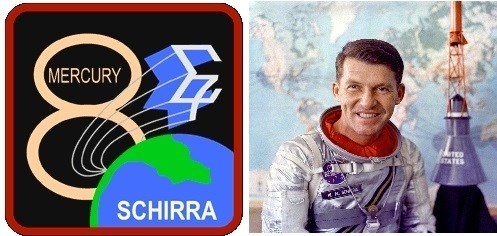Mercury 8
One of 27 caches representing all United States Spaceflight Missions of Projects Mercury, Gemini, and Apollo. This was the 5th of 6 Mercury flights and the 5th of the 27 flights. Click here to see all 27 US Spaceflight caches.
The Mercury 8 spaceflight, more commonly known as Mercury-Atlas 8 (MA-8), or Sigma 7, was the fifth United States human spaceflight, on October 3, 1962, piloted by astronaut Walter "Wally" M. Schirra Jr. It was the fifth crewed flight of Project Mercury, the objective of which was to put an astronaut into orbit around the Earth and return him safely.
The Mercury spacecraft was carried to orbit by an Atlas LV-3B launch vehicle lifting off from Launch Complex 14 at Cape Canaveral, Florida. It orbited the Earth six times in a nine-hour flight focused mainly on technical evaluation rather than on scientific experimentation. This was the longest U.S. manned orbital flight yet achieved in the Space Race, though well behind the several-day record set by the Soviet Vostok 3 earlier in the year. It confirmed the Mercury spacecraft's durability ahead of the one-day Mercury-Atlas 9 mission that followed in 1963.
Planning began for the third U.S. orbital mission in February 1962, aiming for a six-or-seven-orbit flight to build on the previous three-orbit missions. NASA officially announced the mission on June 27, and the flight plan was finalized in late July. The mission focused on engineering tests rather than on scientific experimentation. The mission finally launched on the morning of October 3, having been delayed two weeks because of problems with the Atlas booster. A series of minor booster problems during launch and a faulty temperature controller in Schirra's pressure suit were the only technical problems noted during the flight. The spacecraft orbited in both automated and passive flight modes for prolonged periods while the pilot monitored it and carried out some minor scientific experiments. After six orbits, the capsule landed in the Pacific Ocean half a mile from the recovery carrier, and was hoisted aboard for Schirra to disembark.
The scientific results of the mission were mixed. The astronaut returned healthy after nine hours of confinement in a low-gravity environment. Observation of the Earth's surface proved unproductive, however, because of heavy cloud cover and bad photographic exposures. The public and political reaction was muted compared with that of earlier missions, as the Cuban Missile Crisis soon eclipsed the Space Race in the news. The mission was a technical success: all the engineering objectives were completed without significant malfunctions, and the spacecraft used even less fuel than expected. This confirmed the capabilities of the Mercury spacecraft and allowed NASA to plan with confidence for a day-long flight, MA-9, which had been an early goal of the Mercury program.
Mercury 8 Patch & Walter "Wally" M. Schirra

WHY HERE?
The center point of all the US Spaceflight caches is located in the middle of the intersection where John Glenn Drive changes into Galaxy Way in Concord, CA.
Or as we geocachers would specify it: N 37° 58.700 W 122° 03.259
The distance ranges from this point to the various caches representing the spaceflighst are:
- about ¼ mile - Mercury sub-orbital missions
- about 2 miles - Mercury orbital missions
- about 5 miles - Gemini missions
- about 5 miles - Apollo Earth orbital missions
- about 25 miles - Apollo moon missions
FLIGHT SUMMARY:
| Crew:_ |
_Walter "Wally" M. Schirra - Pilot |
| Launch Vehicle:_ |
_Atlas LV-3B |
| Height:_ |
_94.3 feet |
| Stages:_ |
_2 (counting boost fairing) |
| Stage 1 Diameter:_ |
_16.0 feet with boost faring |
| Stage 1 Thrust:_ |
_341,130 lbf |
| Stage 2 Diameter:_ |
_10.0 feet |
| Stage 2 Thrust:_ |
_81,655 lbf |
| Launch Date & Time:_ |
_October 3, 1962, 12:15:12 UTC |
| Landing Date & Time:_ |
_October 3, 1962, 21:28:22 UTC |
| Duration:_ |
_9 hours, 13 minutes, 15 seconds |
FTF Prize:
This is 1 of 27 caches in KCSearcher's US Spaceflight series that were given away as FTF prizes at his “Man on the Moon, July 20, 1969 - 50 years later” event. For those attendees that received this as a prize, they had an 88 hour head start on those that didn’t attend the event. The prize winners were instructed to sign the log in the “Pre-Publication FTFer(s)” space.
However, for the FTF Hounds that were not able to attend, they too had the opportunity to be FTF on this cache after publication that was targeted for 7/24/2019 @ or around 9:50 AM Pacific Time (splashdown of Apollo 11 + 50 years). All they had to do is find the cache and be first to sign in the “Post-Publication FTFer(s)” space on the log.
BONUS:
Don’t forget to record and save the Code Letter and its associated Number that is on the log sheet and inside the container lid. It will be needed to find a bonus cache on the 51st anniversary of the Moon Landing, July 20, 2020.
Please DO NOT post or include an image of the Code Letter and Number in any of your online logs for this cache
TO LEARN MORE:
Click here to see the Wikipedia description for Mercury-Atlas 8 (MA-8).
Click here to see the Wikipedia description for Project Mercury.
Click here to see the Wikipedia description for the Space Race.